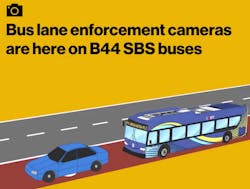New MTA forward-facing cameras on B44 SBS buses begin bus lane enforcement
The Metropolitan Transportation Authority (MTA) New York City Transit (NYCT) has announced new bus-mounted cameras on the B44 Select Bus Service (SBS) route have started enforcement on dedicated bus lanes also used by the B44 and B49 local routes, which will help speed up rides for 37,000 customers.
The MTA began enforcement with camera systems on the M15 SBS fleet in October to enhance the city’s traffic initiative to clear bus lanes, speed up rides and prioritize transit on high-volume corridors.
“Bus-mounted cameras for bus lane enforcement is a turning point for New York City Transit because, for the first time in our history, we can help NYCDOT and the NYPD enforce traffic laws that directly affect our service,” said Craig Cipriano, Acting MTA Bus Company president and senior vice president for buses, NYCT. “We now have an unprecedented level of focus and enforcement efforts to make transit priority such as dedicated bus lanes even more effective, which means faster rides for everyone.”
NYCT is using an Automated Bus Lane Enforcement (ABLE) system on 33 buses serving the B44 SBS route, which travels on approximately 10 miles of dedicated bus lanes implemented by the New York City Department of Transportation (NYCDOT). The bus lanes, which are on portions of Bedford, Rogers and Nostrand Avenues, are also used by the B44 and B49 local routes, which will benefit from faster travel times when these dedicated lanes remain clear of traffic. ABLE camera systems capture evidence such as license plate information, photos and videos, as well as location and timestamp information of vehicles obstructing bus lanes to document bus lane violations. The system collects multiple pieces of evidence to ensure that vehicles making permitted turns from bus lanes are not ticketed. The package of evidence is transmitted to NYCDOT for review and processing, and the program is administered in partnership with NYCDOT and the NYC Department of Finance.
“Traveling all the way from Williamsburg to Sheepshead Bay, the B44 SBS is Brooklyn’s second-busiest bus route -- but one that can and should move even faster,” said NYCDOT Commissioner Polly Trottenberg. “NYCT’s bus-mounted cameras will supplement DOT’s overhead cameras and help ensure that drivers do not stop in the bus lanes along this critical corridor for anything other than expedited pick-ups and drop-offs. We want to thank NYCT President Andy Byford, everyone at the MTA, and the state elected officials who pushed for this essential enforcement program, which will help us make good on [New York City] Mayor [Bill] de Blasio’s Better Buses Action Plan commitment to increase citywide bus speeds by 25 percent.”
Motorists who remain in a bus lane without exiting at the first possible right turn, or they are captured as blocking the bus lane by two successive buses, are considered violating traffic laws and will be ticketed. During the initial 60-day grace period, motorists who block bus lanes are issued a warning that does not carry a fine. At the end of this grace period, motorists who continue to block bus lanes will be subject to a fine of $50 for the first violation, and for additional violations within a 12-month period: $100 for a second offense; $150 for a third offense; $200 for a fourth offense; and $250 for a fifth violation and each subsequent offense thereafter within a 12-month period.
The graduated fine structure applies to the type of violation and is not specific to the bus route, therefore a motorist that is ticketed for blocking a bus lane on the M15 SBS and subsequently is caught blocking a bus lane on the B44 SBS route will be subject to a fine of $100 for the second offense within a 12-month period. The MTA’s bus-mounted cameras enhance NYCDOT’s use of stationary cameras on streets to enforce bus lanes, as well as NYPD’s initiatives to deter parking in bus lanes that began earlier this year.
The MTA’s bus-mounted camera enforcement program will expand to the M14 SBS by the end of November, with the ABLE system to be deployed on a total of 123 buses serving the M15 SBS, B44 SBS and M14 SBS routes. The proposed 2020-2024 Capital Plan includes $85 million for further expansion of the program.
NYCT is working with NYCDOT and NYPD to increase bus lane enforcement in highly congested areas as part of NYCT’s Fast Forward plan to improve bus service, increase bus speeds and attract new ridership. Results so far have yielded faster bus speeds by as much as 19 percent on a portion of Fifth Avenue and as much as 30 percent near the Hugh L. Carey Tunnel’s Manhattan approach. Other strategies include redesigning every borough’s bus network to better meet customer needs, installing traffic signal priority technology, implementing more transit priority street designs and deploying new modern buses with better reliability and customer amenities.
